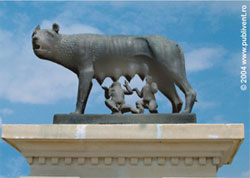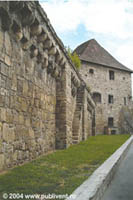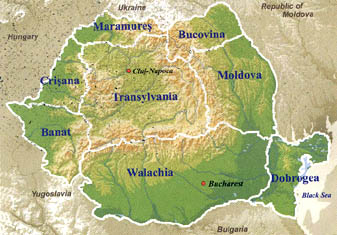|
|
Romanian
and official name: Cluj-Napoca
Hungarian
name: Kolozsvár
German
name: Klausenburg
Population: ~ 350.000 (with large fluctuations due to the student population, estimated to be more than 100.000. |

|
Situated
in west-central Romania, in Transylvania, on the Somes
River. It is the historic capital of Transylvania and the second largest city in Romania, the administrative center of an agricultural and mineral-rich area. Its diverse manufactures include a variety of consumer goods.
The city is also a noted educational center with four
large state universities, plus three smaller private universities,
a branch of the Romanian Academy of Sciences, a Fine Arts
Institute, an Academy of Music, and several scientific
research centers.
NAPOCA was an important Roman city, situated on the river
Samus (Latin name of the river) with its origin in the
Dacian times. The historians associated this name with
the name of native tribes - Naparis, Napaci. Napoca was
situated in the North-West of the Roman province named
Dacia Porolissenis.
|
The Emperor
Hadrian granted Napoca the rank of Municipium with the official
name Aelium Hadrianum Napocenses. In the second half of the IInd
century AD Napoca becomes colonia having the official title of
Colonia Aurelia Napoca.
 |
The
beginning of medieval CLUJ, called in Latin Claudiopolis is
associated with two archeological discoveries on the present
location of the city: the settlement which was developed on
the central area of the city on the ruins of Roman Napoca, and
the wooden stronghold surrounded by a moat in Cluj - Manastur
(Calvaria). Cluj was first mentioned in 1275, in a document
of King Ladislau IV, the Cumanian, when the village of Cluj
City (Villa Kulusvar) was bestowed on the Bishop of Transylvania.
It was made a free city in 1405 by the king of Hungary. Stephen
Bathory founded (1581) a Jesuit academy there, and the city
became (16th cent.) the chief cultural and religious center
of Transylvania. It was incorporated into Austria-Hungary in
1867 and was transferred to Romania in 1920. Hungarian forces
occupied the city during World War II.
Landmarks include the 14th-century Gothic Church of St. Michael,
the house where King Matthias I of Hungary was born (1440),
and the ruins of an 11th-century church. Cluj-Napoca is also
noted for its botanical gardens.
 |
The
name
"Transylvania" comes from Latin and it means
"the land across the forrests", which may be
partly responsible for the aura of mystery, legend, the
stuff that fairy-tales are made of. In
Romanian it is also called "Ardeal", in German
"Siebenbürgen" (the seven cities), and
in Hungarian "Erdély".
Transylvania
is a basin of approximately 56,000 sq. km in the central
part of Romania. North to south, approximately 280 km;
east to west, approximately 310 km. It is bounded by
the East Carpathian range on the northeast, the South
Carpathians (Transylvanian Alps) to the south which
include Romania's highest mountains, Moldoveanu at 2544m
and Negoiu at 2535 m, and the Apuseni (Western) Mountains
to the northwest. |
The
mountains, the hills, the deep forrests, the waters as well
as the towns and villages dating from the medieval ages and
vividly reflecting the mixture of Hungarian, German and Romanian
cultures confer it a unique beauty and charm. Less than 30 minutes
travel in any direction will suprise the traveller by its changing
and breathtaking landscapes.
And
to add even more to the mystery, or possibly because of it,
Bram Stoker placed the action of his novel Dracula in one of
the mountain valleys of north-east, the Borgo Path which starts
from the old town of Bistrita. To read about the legend and
the true story:
http://www.royalty.nu/Europe/Balkan/Dracula.html
Useful
Information
Entering Romania
Visitors to Romania must have a valid passport. EU members do
not require a visa. Visitors from other countries should check
with the Romanian embassies or consulates in their respective
countries. If a visa is required to enter Romania, it is better
to obtain it prior to your visit. Visas may be also obtained
at the point of customs on arrival, but it may cost more and
formalities may take some time.
Language
The official language is Romanian, of Latin origin. English
is well understood and spoken by most people, especially by
the younger generations. French and German are also well understood
or spoken, especially by the older generations. The official
language of the Conference is English.
Local
time
Romania is on East European time zone, namely local time is
2 hours ahead of GMT and 1 hour ahead of most European countries,
i.e. it is 15.00h in Cluj when it is 13.00 in London or 14.00h
in Paris.
Money
and Banking
Local currency:The Romanian currency is LEU, plural LEI (pronounced
as in “lay”); 1 leu is divided into 100 BANI (pronounced
“banny”); all payments are made in the local currency.
In July 2005 there was a devaluation by which 4 zeros were deleted
and at present the old and new coins and notes co-exist. However,
both notes, old and new, with the same value are very similar.
In order to get acquainted with our currency, please visit the
National Bank site at http://www.bnr.ro/En/Ins/ . One Euro
= 3.5 new lei or 35,000 old lei.
Bank cards: All major credit cards are accepted. ATMs are readily
available. There are two ATMs at the Conference Center.
Changing money: You may exchange cash (preferably euros, English
pounds, or US dollars) in all the banks (open 9.00 – 18.00)
or Exchange offices (some of them open 24h). Please note that
in most small shops and at the local market, only cash payments
are accepted.
Telephone
system
The international code for Romania is 40; in order to make an
international call from Romania you must dial 00 followed by
country code and number, e.g. 00 44 for the UK. Romania is well
covered by mobile phone operators (the main ones are Orange
and Vodafone) and if you come from Europe you will be able to
use your mobile phone.
Electricity
Electric current is 230 volts; standard two-pin European style
plugs are used.
Weather
Cluj has a continental climate, with hot summers and cold winters,
not windy and average humidity. September is considered the
most stable month of the year, with the lowest chance of rain.
The average weather in September is sunny with temperatures
around +20 centigrade during the day.
Transportation
By air: The airport is situated about 10 km east of Cluj and
is connected to the city by road; it takes approximately 15
minutes by car between the center and the airport. A special
bus service will be provided for the Conference participants
between the airport and their respective hotels. Please check
the website before the conference for the timetable.
Taxis: Cluj is served by a large number of taxis belonging to
various taxi companies. Useful numbers for calling a taxi are:
947, 946, 953, 969, if you dial from a local phone, or 0040-745-939031,
0040-722-889900 for instance, if you dial from your mobile.
Beside the location you must also give your name in order to
be identified. Taxis may be taken in the street of course, without
calling. Fares are around 30 eurocents / km.
Eating
out
Cluj has numerous restaurants, pizza houses, bars and cafes,
many of them with places for sitting out. Opening hours are
between 11 a.m. and midnight. Standard restaurant food is based
on meat (steaks, grills, stew), vegetarian menus are rather
limited but available, their range depends on every restaurant.
Prices also vary, between 5 – 20 euros (equivalent in
lei) per standard meal per person.
For
additional information about factual Romania, see
http://www.turism.ro/english/factual.php

